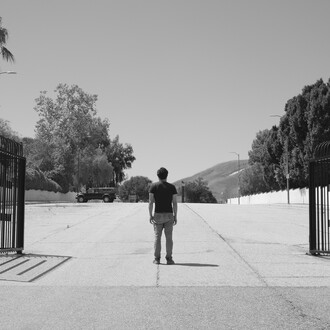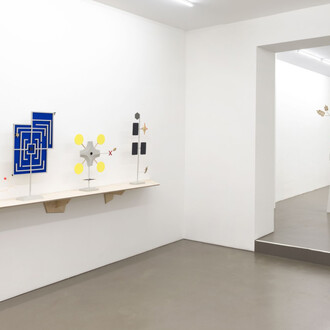Chroma trigger is Phillip Gabriel’s (b. 1983, Jacksonville, US) first exhibition in Germany. The exhibition at Klemm’s Downstairs presents a group of paintings centered on the Spoleto series and the motif of hands. A moving container for histories, desires, and improvisations that resist a single origin, Gabriel’s paintings channel a collision of multiple symbols. He often steals and layers fleeting imagery into congealed surfaces of finessed oil, turning each panel into a cluster of small vignettes and sketchy redactions. These vignettes act like fleeting dreams and form dense, oneiric fields that blur the line between memory and media.
An important reference in Gabriel’s approach is the Filipino jeepney—a four-seater American military jeep that has been modified for public transportation after being abandoned in the wake of World War II. Today, it can still be seen carrying passengers around Manila. These mobile shrines, decorated with an amalgam of anime, brand logos, and Catholic imagery, are important to Gabriel (who is also of Filipino descent), as they embody a container of the aspirations, dreams, and sorrows of their creators, in this way becoming moving canvases through the city.
There is more to the oneiric in Gabriel’s work, however. Amidst glimpses of moody skies, masked faces, and traces of limbs, often floating on opaque colour clouds in the background, his dreamscapes also convey an itinerary of dissection. These motifs often stem from fragments of animated images and video frames, mostly scraps of lost imagery from the internet, thereby crystallising glimpses that would otherwise be evanescent. The provenance does not add up to the meaning. Source, origin, and destination are condensed and reproduced, resembling what Hito Steyerl has coined “the poor image” – a ghost, or the reproduction of a reference that can not be traced back.
While underlining and twisting the ephemeral character of the relationship between viewer and viewed, flirting with an image culture based on prompt capture and short attention spans, this movement also reveals an important sense of gesture. The figure of a hand holding a knife, somewhat ambiguously between threatening and defensive, is central, permeating the exhibition with a feeling of trigger and trauma. Made on a residency in Spoleto in the aftermath of a distressing event, these vignettes come through as sudden memories flashing forward, hands and knives blurred in opaque compositions of bright colours.
















